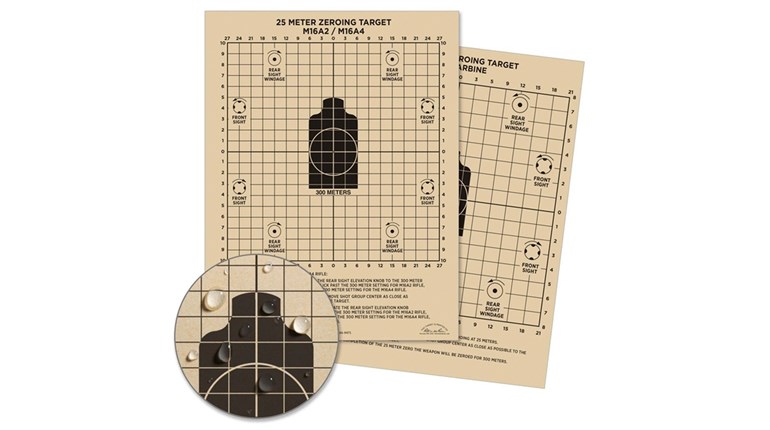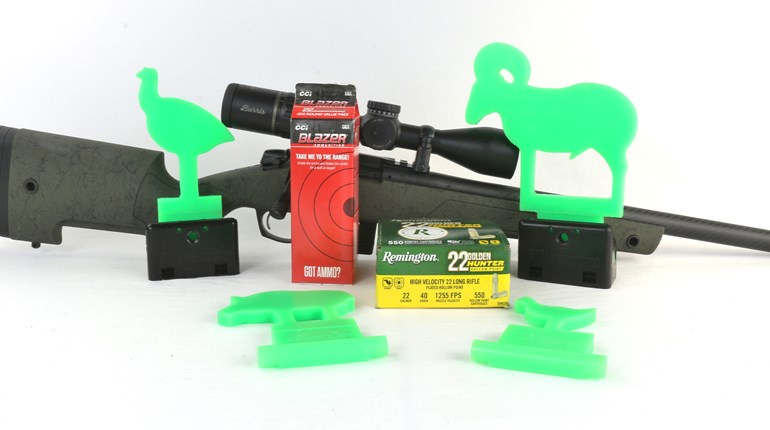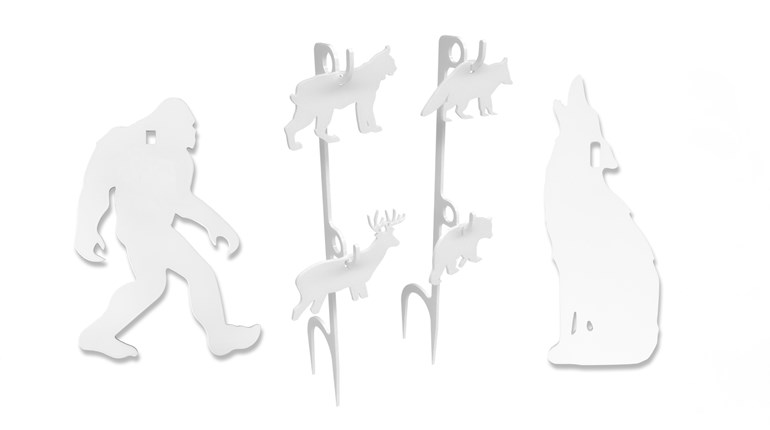
The pluses and minuses of various targets have been topics of late, and we turn our considerations on these to shooting in the great outdoors.
We’ll get the finger wagging out of the way directly: In many ways, shooting outdoors presents more safety issues than indoors. While it’s hard to say for sure, the “wide open spaces” mindset seems to dull cautious instincts that indoor shooting enforces (or accounts for). There’s a tendency to forget that we remain solely responsible for each and every bullet we shoot until it comes safely to rest. Blunder on this when outdoors, and the downrange area of danger and consequence can become huge.
Backstops
Indoors, of course, this is handled by a trap of some sort—both steel and rubber “pellet” variations are widely found. Outside, the trap or backstop is almost always an artificial or natural slope. If the former, you can usually expect that the materials in the slope are known and safely penetrable.
If you’re shooting into a natural slope, however, inspect it first and with some care so that hard, hidden surfaces or materials won’t spit bullets or fragments out in dangerous directions. An easy fix is available here: Keep a hammer and metal stake in your tool kit to render the probing of your impact area easy and rapid.
… in many ways, shooting outdoors presents more safety issues than indoors.The height of artificial berms is generally scaled to the furthest safe shooting position. In cases where the geometry isn’t foolproof or really obvious—a sloped berm floor, for instance—our rule of thumb is never to place a target higher on a stand than what allows impacts through it (and including small misses high) to be any more than halfway up the backstop from the perspective of the physically shortest shooter at the closest engagement distance. Think this geometry through, and you’ll see it keeps bullet strikes safely down in the thick of the backstop, and even puts a slight down-angle on shots for virtually all other shooters. Get the tallest shooter to take a look at your target(s) too—down angle can become too great as well, and this is a ricochet-over-the-backstop hazard.
In short, all shots need to strike the slope (and not the floor) of the berm whether it is natural or manmade. There are rare occasions when striking the ground’s surface is unavoidable, and the best fix is moving the target closer to the berm. You can also remedy this by turning the ground—making it penetrable—behind where any such shots will strike, or through the use of sandbags or mats that suppress or absorb any upward ricochet.
The point here is to have the bullet strike at a relatively high or sharp angle, and in a deep/thick part of the backstop. A shallow or low angle strike invites a skip off—that is ricochet—that may escape the backstop altogether.
Target Stands
You see considerable ingenuity used in solving this problem, not all of it good. It’s also useful to consider why there isn’t a “one-size-fits-all” solution, and clear thinking about the sort of shooting you intend to do saves time, money and aggravation. There are obvious things to avoid, so we’ll dispense with a few of these first.
PVC is still a surprisingly common and well intended choice for target stands. Light in weight and easy to configure, it rarely lasts more than a few trips because of how poorly it responds to even rimfire hits. Not exactly dangerous, it merely leaves a sloppy trail of jagged pieces to the trashcan.
What can be dangerous are metal target posts: Unless these are of quite specific alloys (hard enough to disintegrate incoming projects) and geometry, their propensity to “crater” can very effectively launch bullets or bullet fragments back at the shooter or any nearby spectators with precision, and at easily injurious velocities. The absolute worst we’ve ever seen is rebar: While readily available, scalable, rugged and difficult to hit due to the small necessary diameter, its “whippiness” and ribbing seem to make it a blood-curdling back-slinger of jacket fragments. Fortunately, we have limited (but still unpleasant) experience of this. “T” posts are a rotten choice too: They’re easier to hit, and extremely inclined to crater. The whole point here is to have the bullet strike at a relatively high or sharp angle, and in a deep/thick part of the backstop.
At any rate, the parameters ought to be self-evident—safety (first by a long chalk) and durability. We suggest that the best combination of these is achieved by viewing your target supports as a somewhat longer-lived but still consumable commodity. It’s not surprising that the all-around best choice is also what you see most—wood. Usually in the form of lathe in commercial stands (buy good ones too [these from Dillon], you’ll never be sorry), or DIYed from 2x4s—Mother Nature’s best is the basis for many good variations.
If you prefer the variety and low cost of paper targets, you’ll almost certainly need a backer on which to attach targets to your posts/bases. Here, plywood seems to be the winner. The downside is that this adds weight, modest cost and bulk to your “system”: Either you have some assembly required prior to each use, or they must be transported in a vehicle with a biggish trunk or bed. Note that thickness seems only to add weight and cost; durability is little improved. Even with rimfire, expect your backer to get chewed up fairly rapidly.
Don’t get your knickers in a bunch if you think we’ve left out the other alternate backer material here—cardboard. We’ll get to it presently.
We’ve seen a clever intermediate backing solution that deserves a rebirth, or at least wider consideration—chicken wire stapled between lathe. When not in use, the uprights and backer can be loosely, concentrically and compactly rolled for transport and storage, but set up in a jiffy. Target attachment takes the form of clothespins at the corners of the target, and so handles multiple target sizes with ease. A weird side benefit also accrues—the chicken wire seems to bloody well dodge the bullets behind the target. It’s amazing how few strands are broken even after multiple shooting sessions. Handling requires a little caution as this occurs because severed strands get prickly, but such is easily mended with a side-cutter.
We acknowledge that if you’re shooting on an actively managed outdoor range, both of these considerations may evaporate. Target stands that take all these factors into account are usually provided.
Targets
Now we’re ready to actually shoot something. Paper targets bring tremendous variety to training, and nearly all the benefits we discussed here apply outdoors. Low cost is a major draw as well.
It isn’t usually long, however, before target repair has most folks chaffing a little with the whole paper target business. Indoors, you have a dutiful servant to fetch your tattered target; outside, not so much. If you shoot on a lane-style range, you often have to wait for ceasefire/go “cold,” so multiple aim point targets are a natural solution which cuts way down on standing-around, finger-drumming time.
On a range with separated berms, scampering back and forth may get to rankle. No surprise here—when bullets meet paper, bullets win, and no externally driven necessity to “go cold” means targets can get chewed up in an even greater hurry. Irritatingly, the better you shoot, the more problematic this becomes, hence the old expression, “he’s boring a hole,” and on the multiple bull variety, the more physically fragile that paper target becomes. Wind alone may cause it to unexpectedly disappear.
Technique-wise, you don’t want to get too casual about degrading those aim points either: Getting bored with repair as you train is an open invitation for several bad habits to appear, or perhaps reappear.It isn’t usually long, however, before target repair has most folks chaffing a little with the whole paper target business.
We think literal paper targets—however posted and backed—get more seriously impractical when you move to increasingly tactical or realistic defensive drills. The obvious next step is adding speed or movement, which in turn tends to require more, and more easily “setable” and moveable, targets. This is not a factor for most lane-based ranges—they have very limited provisions for this sort of training.
But it is where we arrive back at our preference for cardboard targets. They are somewhat more expensive and less varied, but on decent stands have two crucial advantages. First, they are rigid enough to stabilize the upright(s) and base, making the cost and bulk of a backer unnecessary. This same physical durability also allows them to “accept” much more repair—a hundred or more shots is not uncommon.
Indoor and outdoor exercise has useful similarities, but also important differences. Urban gunnies are at least able to practice with the proceeding proliferation of modern indoor facilities, and that’s good news—some shooting is considerably better than none. Certainly, fabulous skills can be developed without ever risking a sun- or windburn. That said, most experienced shooters will still aver there’s nothing like training outdoors, and in our third and final—for the moment—discussion of targets, we’ll tempt you with our favorite: steel targets. Almost always an outdoor-only affair, it’s still one that should make you break out the sunscreen and show that Second Amendment, meaningful-liberty engine the light of (a beautiful) day!


































